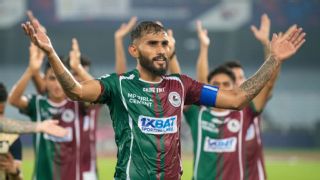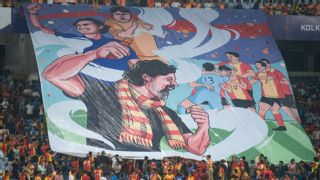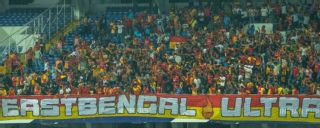|
"Your life can change like that *clicks finger*... my life did!" Kiyan Nassiri knows what a Kolkata derby means more than most. In his first derby, his first real senior match for Mohun Bagan, he had scored a hattrick in half an hour against East Bengal. But long before that match had even kicked off, long before he'd even seriously taken up football as a career, he'd known exactly what this match was about. How could he not? After all, his father is Jamshid Nassiri -- who just happens to be the second highest scoring foreigner in the 124-year history of East Bengal Club. A son becoming a cult legend at 18 for a club whose sworn enemy exalted his father for his goalscoring prowess. You couldn't write it better, and that's exactly what this match is: beyond the fantasy of fiction, capable of scripting tales that get passed on in the way the best tales do, generation-to-generation. ***** Smack bang in the middle of the city of Kolkata is a field they call simply the maidan. Owned by the army, this is where various kinds of sports clubs - bowls, golf, hockey, football - prop up their offices and their own stadiums or simply fenced-off grass squares. Separated by about five minutes walking distance are the "tents" of India's greatest sporting rivals. The gate that leads to one is painted black, with a simple board that says Chuni Goswami Gate, honouring its greatest all-round sportsman. Above that board, three sails: maroon, green, maroon. This was the first of the two clubs to come up: on 15 August 1889, a meeting of society's elite led to the formation of an athletic club to get Bengali youth into sport... they named it after the villa where they held the meeting: Mohun Bagan. This was the club of the native Calcuttans, the ghoti. A few years later, as British colonialism reached its divide-and-rule peak in Bengal, a large number of Bengalis went from the eastern part of the province to the western parts of the state, across the river Padma that served as the notional border. The bangal, as they are called, were treated as all outsiders are the world over, with mistrust and suspicion. It came to a head when in the semifinal of the 1920 Cooch Behar Cup between Mohun Bagan and Jorabagan (another local side), the latter team dropped star player Sailesh Bose. Bose was from Dhaka, and -- so it was perceived -- the native-dominated Jorabagan had discriminated against him. East Bengal Club was born out of that perceived slight. With a bright red board proclaiming its name and a gate that's painted in the in-your-face combination of bright red and yellow, the East Bengal "tent" is five minutes' walk across the maidan from Bagan's. The proximity adds to the tension, and underlines a simple truth -- they are one, yet they are not. ***** "I'm a ghoti, of course I'm a Mohun Bagan fan."  That's Mohun Bagan captain Subhasish Bose and the "of course" is something you hear from both sets of supporters when you ask them of their origins. Not all of them go from watching matches in the stands with their father to captaining their club like Bose but the "of course," "always been a fan of", "forever" are qualifiers that pepper every declaration of fan-ship. For following one of these clubs has got nothing to do with choice, or style of football, or which star plays for which club. You're born into this rivalry on one side or the other. Fans will go into great detail to explain the history of their club, for only if you understand that will you truly understand them. Only then will you be able to comprehend why a differently abled 50+-year-old gentleman has cycled all the way to the Salt Lake stadium to give Mohun Bagan coach Antonio Habas a flower, and take a selfie. Why a 17-year-old boy has bunked school to come see his team practice miles away from his home, why he will answer a question of what this club means with the very dramatic, yet very simple, "Mohun Bagan maa hain." Mohun Bagan is mother. Shiladitya Banerjee, 28, is an Ola cab driver and a die-hard Bagan fan. He has travelled with the team for years now to the point that his calendar revolves around the club's. Once, he says, he told his mother he was going to study at a friend's place in Dum Dum (where the airport is, out of the city) and instead took a train to Siliguri. "I was on the platform the whole night, saw the match, celebrated the win, and came back. Which is when my mother asked me with a smile, 'you'd gone to see the match, na?'" His father has collected paper clippings of Bagan wins for fifty years, so of course the son's obsession was greeted with a knowing smile. This is what connects generations. From the middle-aged Sudipto Roy and Arijit Pal to the young group who call themselves East Bengal Ultras and don't wish to be named they have but one unifying thread: love for their club. Roy has gone to every derby for the past two decades and he's lost sleep in the two days' preceding a derby for each of these years. Pal, meanwhile, talks about his team's 5-0 thrashing of Bagan like it had happened yesterday, and not 1975. When he speaks of one he attended personally -- the 1997 Federation cup semifinal where an almost written off East Bengal beat Bagan thanks to a hattrick from a youngster called Bhaichung Bhutia -- you can feel the religious love in every word. Pal recounts a tale that he believes underscores what his club means to its fans: "I used to go to these matches with a friend, Swapan-da, and he told me this story of another man who used to come to every match from Ranaghat [a town 80 kms from Kolkata]. One derby day that man was late, so late that he walked into his usual stand just before half time. When Swapan-da asked him why he was late, if the trains had been delayed, his response was that he was coming from the cremation of his eldest son." "Imagine the emotions," says Pal. "A father has done what no father has the strength to do, and to forget that he's come to the ground. That's East Bengal, that's the emotion of the bangals." This feeling of emotion is heavy around both clubs, but for East Bengal their fans insist it's a fire (hence, the torch, the mashal, that's their club emblem). "We came from nothing," says one of the EB ultras. "Our forefathers left everything back in the east and built themselves up from scratch." If there was ever a worry that Kolkata might let it's heart by swayed by the glitz of KKR and cricket, remember this... not one of these EB fans would be caught dead in a Sony Norde mask just because he was making a "farewell" tour. That one is entertainment, this is life. As one of the ultras says, "it was, it is, and it always will be everything." ***** There is, of course, change. With India hurtling on through the 21st century and dragging a reluctant Kolkata along with it, that was inevitable. The maidan that was the central hub of football has long since shifted to the massive bowl that is the Yuva Bharati Krirangan stadium, known simply as Salt Lake, after the area it's sat in. Indian football has spread out too, taking its money across: from JCT in Punjab to Dempo and Sporting in Goa to the newer environs of the Blasters in Kerala and Bengaluru and the Mumbai, where the biggest football entity on the planet is now a player. The Calcutta Football League has gone from the country's most important division to a feeder system for the big clubs. And that's combined to take away from the title-defining narrative of the Kolkata derby.  Mohun Bagan, in some form, have remained relevant to the title discussion but East Bengal not so much these days. Even for age-old rivalry context is important: it's only so much fun beating down on somebody that's already miserable. Kolkata -- and by extension it's two greatest clubs -- is no longer the sun around which Indian football orbits... and yet, in a strange way it still is. It could be the blinders-on love of fans (the ultras say that the emotion has gone nowhere, that even a youth team loss hurts to the heavens) or it could be the very nature of this derby, the sheer heft of history... this just means more. Even today. And it's evident to anyone who looks closely enough: "What I see different in Kolkata that I haven't seen in Turkey (Istanbul) or Spain," says Carles Cuadrat, East Bengal manager, "is the way people cry with happiness. In a very personal way, they feel touched by victories and also by defeats. In Turkey and Spain, you see everybody celebrating together , a lot of smiles and a lot of jokes. Here, it is more a deep feeling, like a sense of justice: 'We need that, we really need that.'" That sense of justice is important: the two clubs exist not only on the love of its fans, but get fuelled by the hatred of its rivals. As important as us winning is them losing -- and that's what keeps the flame lit through the toughest of odds. ***** Change, though, isn't always bad. The two sets of ultras this writer spoke to at their respective maidan tents are part of a newer generation of fans, who are looking to do things a little differently.  "When we used to chant in the beginning," say both sets of ultras (curiously), "we used to get abused by old-timers from our own team. Our culture of watching is simple -- if our team is winning shout in joy, if they are losing hurl abuse after choice abuse -- and so this 'westernisation' of support wasn't welcomed by all." They've grown in numbers, though, because their message has universal appeal: support through thick and thin (and expressing that support), bring about inclusivity and get more women fans on board, break out from the conservative shell of their previous generations. The EB ultras, formed in 2013, believe they were the first ones to organize themselves into a formal group. The MB ultras soon followed. They were the ones behind the famous banners that protested the draconian Citizenship Amendment Act (CAA). One East Bengal banner at the time read: "This land has been bought with our blood, not with documents". Bagan's: "We were here before there were papers". They are not one... yet they are. And that's why the Kolkata derby will forever remain special.
|

